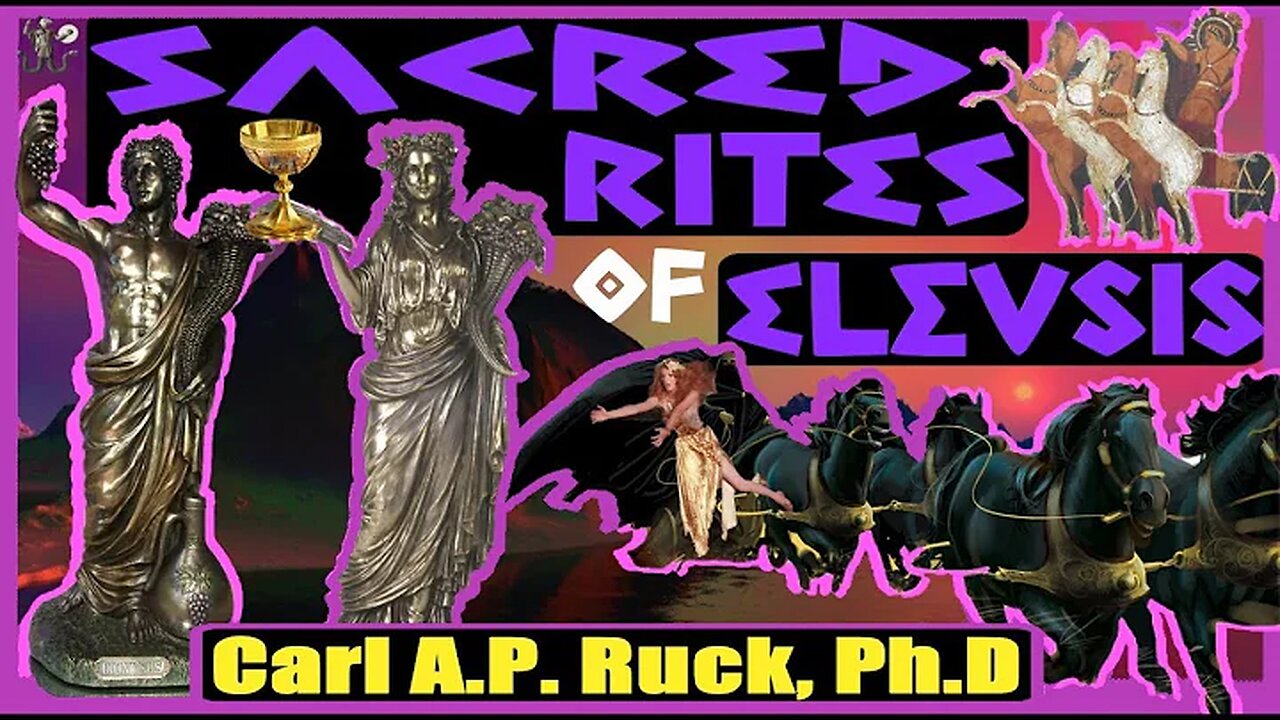Premium Only Content

Eleusinian Rites & Christ. Harvard Prof. Carl A.P. Ruck. Sacred Hallucinogens, Myth & Religion
Eleusinian Rites & Christ. Harvard Prof. Carl A.P. Ruck. Sacred Hallucinogens, Myth & Religion
-
Harvard Prof. Carl A.P. Ruck: There is a reason that the Jews were not Christian's. Because Christianity is not Jewish, but Hellenistic
-
28,492 views April 1, 2022
Gnostic Informant
-
Imagine the coming together of some of the worlds most famous experts on Hallucinogens, trying to determine WHAT Substance was used by the Greek Mystery School Esoteric Rites of the Eleusinian Cult (Actually Taking Doses):
-
Albert Hoffman: Discoverer of LSD
-
L.Gordan Wasson: Mushroom/Hallucinogen Expert tied to the CIA
-
John Allegro: Dead Sea Scroll Scholar and Author of the Mushroom and the Cross
-
Prof. Carl A.P. Ruck: Now an Expert on the Eleusinian Rites
-
Aspects of Drug Use in Classical Greece
5:59
The Hymn Demeter
18:27
Anointed Savior Idea Come from
31:18
Why Did the Savior Have To Be Anointed
31:29
Time Is an Illusion
41:41
Wine Diluted with Water
52:54
-
FAIR USE FOR EDUCATIONAL PURPOSES
-
Mirrored From:
https://www.youtube.com/@GnosticInformant
-
The Eleusinian Mysteries (Greek: Ἐλευσίνια Μυστήρια, romanized: Eleusínia Mystḗria) were initiations held every year for the cult of Demeter and Persephone based at the Panhellenic Sanctuary of Eleusis in ancient Greece.
-
They are the "most famous of the secret religious rites of ancient Greece". Their basis was an old agrarian cult, and there is some evidence that they were derived from the religious practices of the Mycenean period.
-
The Mysteries represented the myth of the abduction of Persephone from her mother Demeter by the king of the underworld Hades, in a cycle with three phases: the descent (loss), the search, and the ascent, with the main theme being the ascent (ἄνοδος) of Persephone and the reunion with her mother.
-
It was a major festival during the Hellenic era, and later spread to Rome. (This later became so out of control, that the Rites were Banned in Rome)
-
Similar religious rites appear in the agricultural societies of the Near East and in Minoan Crete. The Mysteries are related to a myth concerning Demeter, the goddess of agriculture and fertility as recounted in one of the Homeric Hymns (c. 650 BC). According to the hymn, Demeter's daughter Persephone (also referred to as Kore, "maiden") was assigned the task of painting all the flowers of the earth. Before completion, she was seized by Hades, the god of the underworld, who took her to his underworld kingdom. Distraught, Demeter searched high and low for her daughter. Because of her distress, and in an effort to coerce Zeus to allow the return of her daughter, she caused a terrible drought in which the people suffered and starved, depriving the gods of sacrifice and worship.
-
As a result, Zeus relented and allowed Persephone to return to her mother. According to the myth, during her search Demeter traveled long distances and had many minor adventures along the way. In one she taught the secrets of agriculture to Triptolemus. Finally, by consulting Zeus, Demeter reunited with her daughter and the earth returned to its former verdure and prosperity: the first spring.
-
Zeus, pressed by the cries of the hungry people and by the other deities who also heard their anguish, forced Hades to return Persephone. However, it was a rule of the Fates that whoever consumed food or drink in the Underworld was doomed to spend eternity there. Before Persephone was released to Hermes, who had been sent to retrieve her, Hades tricked her into eating pomegranate seeds (either six or four according to the telling), which forced her to return to the underworld for some months each year. She was obliged to remain with Hades for six or four months (one month per seed) and lived above ground with her mother for the rest of the year.
-
This left a long period of time when Demeter was unhappy due to Persephone's absence, neglecting to cultivate the earth. When Persephone returned to the surface, Demeter became joyful and cared for the earth again. In the central foundation document of the mystery, the Homeric Hymn to Demeter line 415, Persephone is said to stay in Hades during winter and return to her mother in the spring of the year: "This was the day [of Persephone's return], at the very beginning of bountiful springtime."
-
Persephone's rebirth is symbolic of the rebirth of all plant life and the symbol of eternity of life that flows from the generations that spring from each other. Kykeon (Ancient Greek: κυκεών, kykeȏn; from κυκάω, "to stir, to mix") was an Ancient Greek drink of various descriptions. Some were made mainly of water, barley and naturally occurring substances. Others were made with wine and grated cheese. It is widely believed that kykeon usually refers to a psychoactive compounded brew, as in the case of the Eleusinian Mysteries. A kykeon was used at the climax of the Eleusinian Mysteries to break a sacred fast, but it is also mentioned as a favourite drink of Greek peasants.
-
Professor Carl Ruck, Ph.D (Harvard) Classicist https://www.bu.edu/classics/faculty-p...
-
Carl A.P. Ruck is an authority on the ecstatic rituals of the god Dionysus. With the ethno-mycologist R. Gordon Wasson and Albert Hofmann, he identified the secret psychoactive ingredient in the visionary potion that was drunk by the initiates at the Eleusinian Mystery. In Persephone’s Quest: Entheogens and the Origins of Religion, he proclaimed the centrality of psychoactive sacraments at the very beginnings of religion, employing the neologism “entheogen” to free the topic from the pejorative connotations for words like drug or hallucinogen.
www.entheomedia.net Ethno-mycologist R. Gordon Wasson: www.wassonwest.org
-
 1:27:11
1:27:11
Omar Elattar
9 hours agoThe Dating Expert: "I've Helped 4,000 Men Find LOVE!" - The #1 Alpha Trait Women Secretly Crave!
20K -
 LIVE
LIVE
VOPUSARADIO
9 hours agoPOLITI-SHOCK! "END THE FED, END THE LIES & END THE DEEP STATE ONCE AND FOR ALL"!
149 watching -
 1:43:38
1:43:38
LumpyPotatoX2
4 hours agoRumble Creator Round-Table - Let's Talk About It
22.2K2 -
 32:38
32:38
The Mel K Show
7 hours agoMel K & Dr. James Thorp, MD | Sacrifice: The Targeting of the Most Vulnerable | 7-24-25
27.6K10 -
 1:12:41
1:12:41
Donald Trump Jr.
6 hours agoFrom Crypto to AI, There's a New American Energy Revival, Interviews with Asher Genoot & Sen McCormick | TRIGGERED Ep.261
155K53 -
 52:11
52:11
ZeeeMedia
9 hours ago"Meaningful Deep State Prosecution" ft. Robert Barnes | Daily Pulse Ep. 73
38.5K8 -
 8:10
8:10
MattMorseTV
7 hours ago $3.22 earnedThey just CAVED.
29.1K25 -
 14:55
14:55
Tundra Tactical
6 hours ago $0.56 earnedTundra's EXPLOSIVE SIG Meme Review
14.5K1 -
 3:01:22
3:01:22
Joker Effect
3 hours agoThe told me to go to H3LL...... well... I am here and causing chaos now. HORROR GAMEPLAY ONLY! :)
13.6K5 -
 LIVE
LIVE
Mally_Mouse
5 hours agoLet's Hang!! --10K Follower Celebration!!!
64 watching